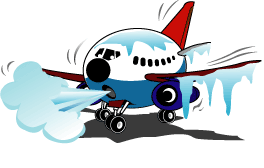 |
|||||||
| Issue Number 278 |
November,
2002
|
||||||
|
P.O. Box 189, Moffett Field, CA 94035-0189 |
|||||||
|
|
|||||||
 |
|||||||
| Issue Number 278 |
November,
2002
|
||||||
|
P.O. Box 189, Moffett Field, CA 94035-0189 |
|||||||
|
|
|||||||

 While
there have only been scattered flurries of weather-related ASRS reports
recently, the forecast is for increasing intensity over the next few
months. On the brighter side, ASRS Analysts do see a chance for significant
clearing of embedded gray cells and foggy memories provided there
is heavy participation in a review of cold weather operations and
procedures. A high absorption rate of the towering accumulation of
lessons learned could prevent an avalanche of reports at ASRS.
While
there have only been scattered flurries of weather-related ASRS reports
recently, the forecast is for increasing intensity over the next few
months. On the brighter side, ASRS Analysts do see a chance for significant
clearing of embedded gray cells and foggy memories provided there
is heavy participation in a review of cold weather operations and
procedures. A high absorption rate of the towering accumulation of
lessons learned could prevent an avalanche of reports at ASRS.
 This
"chilling" statement reflects the gravity of the situation
encountered by an instructor and student in an ice-encumbered Cessna
172. Knowing the limitations of one's aircraft and having a respect
for the forces of nature are two universal lessons learned by the
instructor who submitted this report.
This
"chilling" statement reflects the gravity of the situation
encountered by an instructor and student in an ice-encumbered Cessna
172. Knowing the limitations of one's aircraft and having a respect
for the forces of nature are two universal lessons learned by the
instructor who submitted this report.
Causes: We took off into forecast icing conditions... I thought if we could get up high enough (10,000 feet) we could fly over the icing layer...
Even a very thin layer of ice on the leading edge and upper wing surfaces can cause a dramatic loss of lift and increase in drag. With two inches of ice, these pilots were lucky to be near an airport.
![]()
Quick work by a sharp Center Controller not only helped an MD-80 crew out of a bad situation, but also prevented a "chain reaction" of traffic conflicts. This first report gives the Controller's perspective.
And the following report details the pilot's view of the same incident:
It appears that the aircraft may have been operating at, or close to, its performance limit altitude for the thrust available and that the encounter with the effects of the thunderstorm resulted in the inability to maintain altitude.
![]()
While airborne incidents may involve more drama, a snow-covered airport can be a stage for a medley of errors.
![]()
The MD-80
Captain in this report stepped in on cue, but even with the help of
a proficient understudy, couldn't save the scene.
scene.
![]()
The B737 Captain who submitted this report was all set for ice and snow, but oil and rain stole the show.
The rain, in combination with oils from the asphalt and tire rubber made a normal taxi onto the runway for takeoff a very slippery situation. It has made me very wary of all wet runway and taxiway evolutions. During the winter I tend to focus on snow and ice, but this situation...could put you off a runway or taxiway when you are not expecting to slip.
![]()
When the wings aren't "working" airplanes have to be "driven" on runways and taxiways. Anyone who has lost control of a car on an icy road knows the helpless feeling when the vehicle doesn't respond to steering inputs. But imagine the emotions these two maintenance technicians experienced when they lost control of a large, turbojet aircraft. One of them describes the "impact" of cold-weather taxi operations in his report to ASRS.
 Even
after parking, an extended period of vigilance might be required when
there is ice on the ramp. After the chocks were put in and the engines
secured, the Captain who submitted the next report thought it was
time to leave…but so did the airplane.
Even
after parking, an extended period of vigilance might be required when
there is ice on the ramp. After the chocks were put in and the engines
secured, the Captain who submitted the next report thought it was
time to leave…but so did the airplane.
| ASRS Recently Issued Alerts On... |
| B757 lavatory fire incident |
| Homebuilt Kitfox rubber hose failure |
| CL65 uncommanded nose gear retraction |
| Published SID discrepancy at a Mexican airport |
| An international airport's taxiway signage and marking |
|
October
2002 Report Intake
|
|
| Air Carrier/Air Taxi Pilots |
1,914
|
| General Aviation Pilots |
741
|
| Controllers |
51
|
| Cabin/Mechanics/Military/Other |
114
|
| TOTAL |
2,820
|